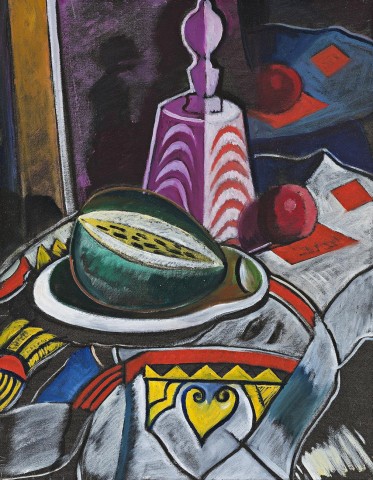STILL LIFE WITH MELON AND BELL
ROY DE MAISTRE
oil on canvas
46.0 x 35.5 cm
bears inscription on frame verso: “Still Life with Melon & Bell” Painting by Roy de Maistre / stamped with the facsimile of his signature by his Executor Doris de M Fischer
artist’s studio stamp on frame verso
Estate of the artist, London, 1980
Joseph Brown Gallery, Melbourne, c.1982
Ken and Joan Plomley Collection of Modernist Art, Melbourne
Roy de Maistre’s studio at 13 Eccleston Street, Belgravia, was on the ground floor of an otherwise nondescript three-storey building. On stepping inside, a personal paradise was revealed, described famously as being like an Aladdin’s Cave, 'a visual delight glowing with colour … a cavern of colour and intimacy’.1 Patrick White, who lived upstairs in 1937, wrote memorably that ‘in Eccleston Street, in the de Maistre studio-salon, I met … important people, among them Henry Moore, Graham Sutherland, (and) Francis Bacon.2 After many years at the forefront of his London activities alongside such members of the British avant-garde, de Maistre retreated to his studio, an enduring source of renewal and inspiration. Of his alternating painterly sequences, the still lifes and studio interiors from these years are amongst his most collected work.
In Still Life with Melon and Bell, the viewer is drawn to a corner of the studio, an action of sighting memorably described by the artist’s friend and supporter, Sir John Rothenstein, who wrote that de Maistre ‘looks with fascinated intensity about the (studio) and this scrutiny, searching yet affectionate, has made him a kind of intimiste. … Each object of contemplation (has) been combined in lucid, close-knit arrangements expressive of the painter’s relation to his surroundings’.3 These are works which still retain the echo of aspects of Picasso’s Cubist divisions but there is also the presence of Matisse, Max Beckmann, Juan Gris and, of course, the artist himself. The strong black outlines, which first appear in de Maistre’s oeuvre in works such as Marriage, 1936, form yet another linkage, this time with the mannered cubist style of the English Vorticist painter Wyndham Lewis. De Maistre utilises a repeating, curvilinear pattern to animate the surface of the bell in Still Life with Melon and Bell and this, in turn, responds to the semi-circular edges of the melon’s ripe interior. Both objects sit upon a richly patterned cloth, and De Maistre was already well known for his use of modern European fabrics as a prop in his paintings, as Gerberas, 1926 (lot 1 in this auction) demonstrates.
Another feature of the studio was the collection of the artist’s own paintings, a living testament to his extensive career, where ‘paintings dating back to his earliest works, (were) always displayed on the walls, on tables leaning against the walls, and on easels, … parts of de Maistre’s self he loathed to part with’.4 The fact that Still Life with Melon and Bell stayed within the artist’s estate is testament to his own affection for this particular painting. Despite his almost hermitic existence, de Maistre was still championed by certain galleries. In 1956, for example, he was included in the Exhibition of Contemporary British Art at the E. & A. Silberman Galleries in New York, alongside Bacon, Sutherland, Ceri Richards, Ben Nicholson, William Scott and others. The National Gallery of Australia and the Art Gallery of New South Wales are important collectors of de Maistre’s studio-interior paintings, and other examples related to Still life with Melon and Bell include Still Life, 1954 (Tate Gallery, London); Still Life with Bottle and Fruit, 1940s – 50s (Deutscher and Hackett, 29 August 2018, lot 20); and Still Life with Pineapple, c.1954 (formerly collection of Caroline de Mestre).
1. Johnson, H., Roy de Maistre: The English Years 1930 – 1968, Craftsman House, Sydney, 1995, p. 48
2. White, P., Flaws in the Glass, Jonathon Cape, London, 1981, p. 62
3. Rothenstein, J., ‘Introduction’, Roy de Maistre: A Retrospective. Exhibition of Paintings from 1917-1960, Whitechapel Art Gallery, London, May 1960, p. 9
4. Johnson, J., ibid., p. 52
ANDREW GAYNOR
